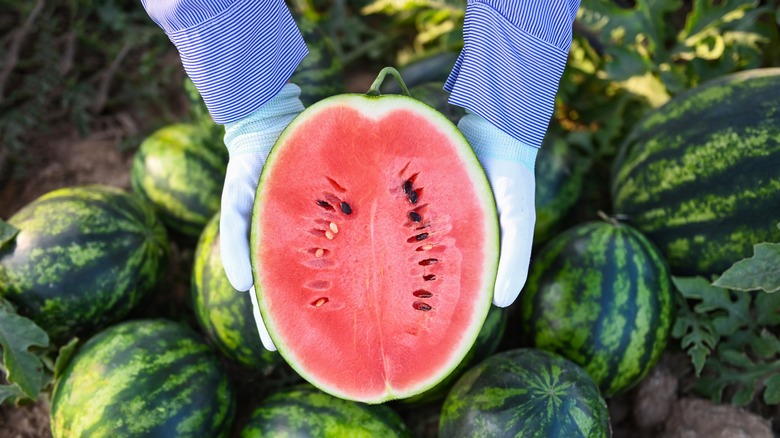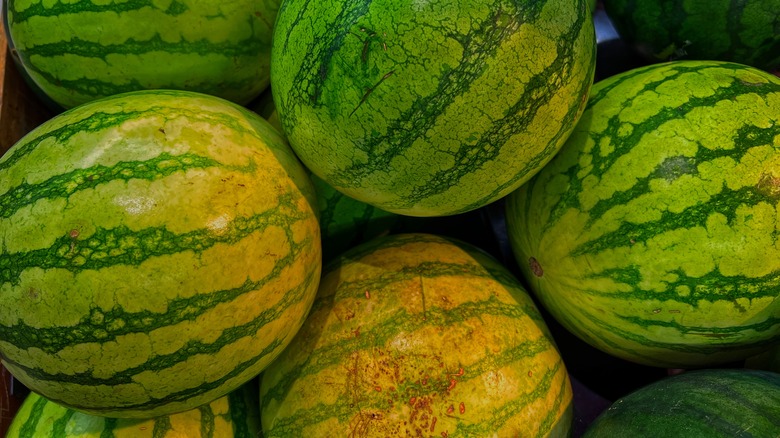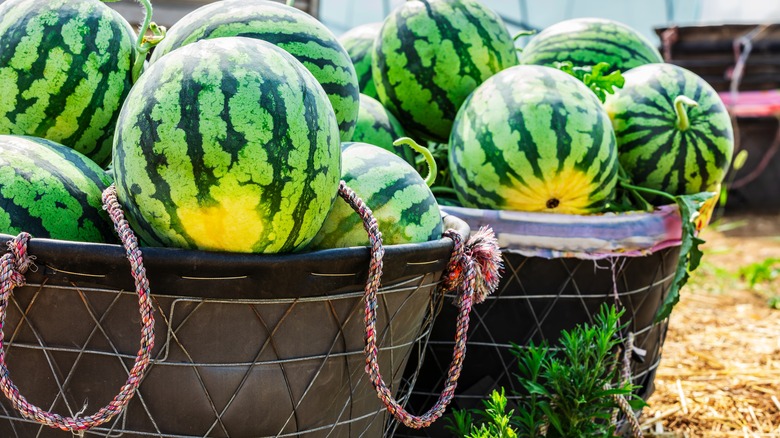Three Easy Tips To Know When Your Watermelons Are Ripe And Ready To Harvest
Summer means warm weather, BBQs, and ripe, delicious watermelon. If you've been growing your melons and patiently waiting for the time to harvest them and take that first sweet, juicy bite of the inner fruit, there's nothing more disappointing than getting a flavorless, unripe taste after months of tending. Rather than risk picking your watermelons before they are ready, know the signs to grab the best ones that are sure to be bursting with flavor. Three of the simplest ways to determine if a melon is ripe are to check on the grow spot, observe each fruit's shell for uniformity, and listen for the ideal sound when tapping on the exterior.
Watermelons need between 80 days and 100 days to grow and ripen properly, and the best time to plant watermelons is in late spring so you can get a good harvest for the warmer months. However, several factors affect their readiness. The pH of your soil has a significant impact on how well this fruit grows, and water interference outside the normal amount could create cracks that render your melons inedible. Your soil pH is best at a 6.0 (and up to 6.5) acidity for watermelon production, allowing the fruits to get the correct nutrients to help them grow. You shouldn't plant watermelons near other melons, either. Likely, bugs will converge on the sweet fruits and could ruin them. Once your crop looks ready to harvest, start by examining each one before plucking them.
Check the field spot and the rind
When checking for uniformity in your watermelons, you want to look at several factors. If the rind is too shiny, it means the fruit hasn't yet ripened properly. Ripe melons will be similar in size and circumference with a rounded or oval shape; when choosing which ones are good for picking, avoid narrow, oblong fruits. If you notice odd indentations or depressions, it could also be a sign that the fruit is not ripe — or lacks sufficient nutrients and water — so these likely won't taste as good.
As your watermelon grows, it develops a field spot, which is a discoloration that shows where the fruit sat against the soil. Before you harvest a melon, check the field or grow spot, which can help you determine its ripeness. Yellow spots are indicative of sweet pulp inside the rind, while green spots likely mean the fruit isn't ready for harvest. White spots also show the watermelon isn't as juicy or sweet as those with yellow circles.
Try tapping the watermelon to determine readiness
Visual queues are great for deciding if your watermelons are ready to harvest. However, one other way can test if your fruit is ready to come off the vine: the tap test. Opinions vary on whether or not this method is the most soluble since it can be tricky to tell the difference between the knocking sounds produced when you tap the melon. If you knock or tap on the rind and a hollow sound is what you hear, this can mean the fruit is too ripe, and therefore, not worth eating. Tapping on the exterior and noting a higher pitch reverberating inside indicates that the melon isn't ready for picking and hasn't ripened enough.
A watermelon of the ideal ripeness should create a thud that sounds somewhat hollow but deep and resonating, unlike overly ripe fruit, which will sound empty. It can be tricky to use this method, especially if you're not versed in the different tapping results, so check both the uniformity and field spots first before trying this. That way, you can use all three to determine if your watermelon is ready and will taste as good as you hoped. After all, if you waited this long to pick your ripened produce from your garden, why waste that first bite on anything other than perfection?


